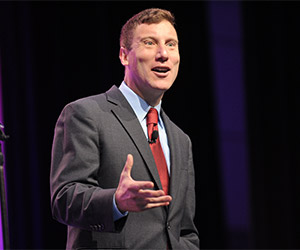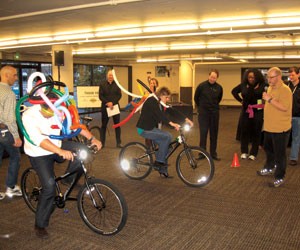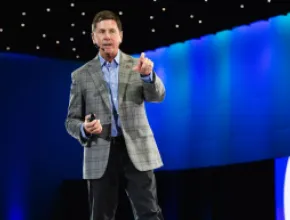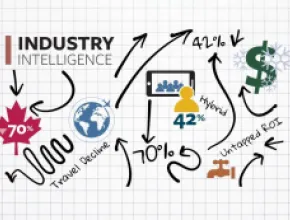Diversity can breed conflict, and today's work teams are more generationally diverse than ever. In any one company there may be people from five different generations working together, all with different career ethics, goals and values.
Fortunately, team-building activities can help surmount the sometimes uncomfortable issues that arise from generational differences.
"Generational diversity is the number one issue in workforces these days," says Wayne Bennett, president of TeamWorx Team Building LLC in Sacramento, Calif. "A lot of companies come to me saying they are not communicating effectively, but when I take a closer look, I realize those issues are related to generational clash points.
"If you don't understand why someone does something a certain way," he continues, "you may start to not like the person instead of realizing their behavior has more to do with their generation than anything else."
Teams of workers born during different eras go through different developmental stages, explains Bruce Tulgan, of Rainmaker Thinking, Inc, a management consultancy in New Haven, Conn., and author of Managing Generation X.
"We all went through different accidents of history through our life stages," he says.
What are the different generations in the workplace?
Before attempting to meld multi-generational teams, Bennett says it's important to understand each group and how they handle work situations. The generations currently in the workplace include the following.
- Traditionalists
- Baby Boomers
- Generation Xers
- Millennials
- Gen Zers
"Traditionalists are anyone who was born between 1900 and 1945," he says. "They are stereotypically loyal, patriotic, hard working, fiscally conservative and have faith in institutions."
In the workplace, these individuals are not big fans of feedback, Bennett notes.
"They take the 'no news is good news' approach and think 'If my boss isn't talking to me, I must be doing well,'" he says.
Next up are the Baby Boomers. These are individuals born between 1946 and 1964. According to many reports, there are more the 80 million of them in the U.S., making them the largest generational demographic.
"Unlike the traditionalists, Baby Boomers question authority; they said no to war, which was opposite of their parents," Bennett says. "They are idealistic and have problems with change. They also had lots of kids and lots of divorces."
At work, Bennett says Baby Boomers are an incredibly competitive bunch that feels they need to bide their time before getting promoted. The group prefers yearly feedback in the office, with lots of documentation.
Generation X, born between 1965 and 1981, are quite a bit different than their Baby Boomer predecessors, primarily in their view of independence.
"We are a generation of latchkey kids, which was a totally new thing," says Bennett, a self-proclaimed Generation Xer. "Kids were walking home to houses that were empty, so our parents expected us to be independent."
As a result, persons from this generation are adaptive and unfazed by change—quite the opposite from the previous generation. At work, they prefer frequent feedback from superiors.
"They have the 'just tell me and let's get on with it' attitude," Bennett notes.
Millennials consist of persons born between 1981 and roughly 2000. This is a group of people vastly different from the other generations, partly because of technological advances, but also because they have a less competitive, open-minded outlook on work and life, according to Bennett.
"They are very globally concerned and are also uninterested in following seniority ranks at work—unlike Baby Boomers," he adds. "They don't think that time is a factor in promotion, they focus on results and want to become a vice president in a year, for example."
The Millennial generation is also obsessed with getting feedback about job performance.
"They want it constantly—to the point of neediness," Bennett says, adding that the Millennial generation is also focused on teamwork, instead of working independently.
Related: Managing Millennial attendees means embracing technology
Generation Z, born roughly between the mid-1990s and the mid-2000s, are as tech-focused as Millennials, using their smartphones over any type of device, and possess other similarities as well as differences when compared to their predecessors.
They’ll take a cool product over a cool experience, they’re into edgy things and don’t like conformity and tradition, and they want to be a part of creating culture and changing the world.
Cultural competence when working with different generations
 When different generations are put together, it can make for an exercise in extreme frustration. That is where experts such as Tulgan and Bennett say the right approach to team building can help bridge the various generation gaps.
When different generations are put together, it can make for an exercise in extreme frustration. That is where experts such as Tulgan and Bennett say the right approach to team building can help bridge the various generation gaps.
Generational conflicts can be touchy subjects. Tulgan recommends structuring serious team-building activities where groups tackle problems head on.
"The most important thing is to recognize that these are real issues," he says. "Make sure the activities you set up are not contrived; we are not talking about doing trust falls or building LEGO castles. Instead it is good to have focused conversations about working relationships, about differences team members perceive in one another, strengths in themselves and others, and areas for improvement."
Tulgan breaks his team-building activity into a few steps:
- Identify a business objective. "It could be instilling confidence and trust in each other or communicating better in the workplace," he says.
- Split up the participants into teams by generation."Have each group clustered by who is closest in age—organize by birth year," he says.
- Each team gathers for an in-depth conversation around generational issues. "Ask each other what you perceive as traits of your generation; what your strengths are and what your weaknesses are; the best things and worst things about how your generation communicates," Tulgan says. "Make a top 10 list."
- Each generational team presents their findings to the overall participants.
- Discussion across groups
Why does this exercise work?
"The primary deliverable to this exercise is to establish insights and best practices," Tulgan says. "Moving forward, people may not be as irritated by someone because they will understand where they are coming from.
"Once team members understand generational traits, they may be more likely to discuss how to meld groups more effectively," he continues. "For example, maybe a team should have a meeting for an hour a week to discuss shared problems and solutions. This exercise may help them realize that that is what they need. This helps colleagues ask real-world questions about real-world relationships—it isn't a game. I recommend creating action plans and commitments at the end."
Another approach for different generations to interact
Bennett has a different approach to multi-generational team building. He recommends starting off an activity with an in-depth presentation of generational differences.
"Get the team into the same room and introduce this information," he advises. "It will help depersonalize problems and help people understand what influenced each generation. Make it interactive and try to prepare in advance for someone from each generation to explain its traits. If you do invite other participants to present, make sure to practice and make it fun."
Next, he recommends passing out trivia cards with questions such as "How much did milk cost in 1941?" Each card should contain 12 questions, three for each generation.
"Go around and ask people these questions," Bennett says, adding that the answers will yield some interesting variations.
Bennett says this is effective because it makes for improved communication between the generations.
"It is helpful in creating a human connection with a person and conveying that you are listening and want to learn about them," he says. "It will take what normally would be very personalized interactions, for example, 'I don't like Sue because she does this and that,' into 'I now understand Sue because she is a Generation Xer.'"
Katie Morell is a Chicago-based freelance writer and former Meetings Today editor.
Some of the links in this article are affiliate links.
This was first written in 2011 and updated in 2018 to reflect Generation Z.






